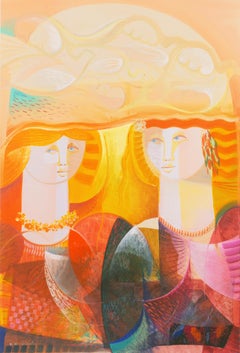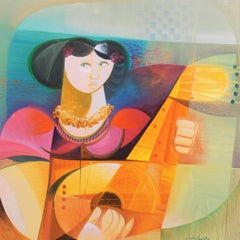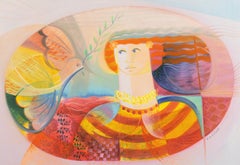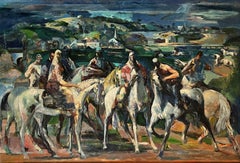Vittorio Maria Di Carlo Paintings
to
2
6
3
3
2
1
1
3
2
Overall Height
to
Overall Width
to
6
6
6
6
3
2
2
1
6
3
6
903
649
639
610
6
6
3
3
Artist: Vittorio Maria Di Carlo
Figura Col Pappagallo
By Vittorio Maria Di Carlo
Located in San Francisco, CA
This artwork titled "Figura Col Pappagallo" is an oil painting on canvas by Italian artist Vittorio Maria Di Carlo, 1939-2015. It is hand signed at the lower right corner by the arti...
Category
Late 20th Century Modern Vittorio Maria Di Carlo Paintings
Materials
Oil
'Lovers beneath a Tree of Doves', New Figurative Movement, Italian Modernist Oil
By Vittorio Maria Di Carlo
Located in Santa Cruz, CA
Signed lower left, 'V.M. Di Carlo' for Vittorio Maria Di Carlo (Italian, 1939-2015) and painted circa 1980.
Born in San Marco, Maria Vittorio Di Carlo...
Category
1980s Modern Vittorio Maria Di Carlo Paintings
Materials
Canvas, Oil
Le Amiche
By Vittorio Maria Di Carlo
Located in San Francisco, CA
This artwork titled "Le Amiche" is an oil painting on canvas by Italian artist Vittorio Maria Di Carlo, 1939-2015. It is hand signed at the lower right corner by the artist. The canv...
Category
Late 20th Century Modern Vittorio Maria Di Carlo Paintings
Materials
Oil
Naschera
By Vittorio Maria Di Carlo
Located in San Francisco, CA
This artwork titled "Naschera" is an oil painting on canvas by Italian artist Vittorio Maria Di Carlo, 1939-2015. It is hand signed at the lower left corner by the artist. The canvas...
Category
Late 20th Century Modern Vittorio Maria Di Carlo Paintings
Materials
Oil
'Woman playing a Lute', New Figurative Movement, Italian Modernism, Large Oil
By Vittorio Maria Di Carlo
Located in Santa Cruz, CA
Signed lower right, 'V.M. Di Carlo' for Vittorio Maria Di Carlo (Italian, 1939-2015) and painted circa 1980. Accompanied by artist label with title, 'Musicante' and gallery exhibition information.
Born in San Marco, Maria Vittorio Di Carlo...
Category
1980s Modern Vittorio Maria Di Carlo Paintings
Materials
Oil, Canvas
'Dove of Peace', Large Oil, New Figurative Movement, Italian Modernism, Biennale
By Vittorio Maria Di Carlo
Located in Santa Cruz, CA
Signed lower right, 'V.M. Di Carlo' for Vittorio Maria Di Carlo (Italian, 1939-2015) and painted circa 1980.
Born in San Marco, Maria Vittorio Di Carlo...
Category
1980s Modern Vittorio Maria Di Carlo Paintings
Materials
Canvas, Oil
Related Items
Figurative landscape oil painting- The Spring
Located in Beijing, CN
Dai Xiangwen was born in Hunan in 1991 and graduated from the Academy of Fine Arts of Jianghan University,
He is a member of China Artists Association, China Designers Association, a painter of Li Keran...
Category
2010s Modern Vittorio Maria Di Carlo Paintings
Materials
Canvas, Oil
Riders of Pigeon Hill
By Jon Corbino
Located in Los Angeles, CA
Riders of Pigeon Hill, c. 1940s, oil on canvas, signed lower right, 24 x 36 inches, label verso with title, artist’s name and address; same information inscribed verso; ex-collection...
Category
1940s American Modern Vittorio Maria Di Carlo Paintings
Materials
Canvas, Oil
A Day at the Beach
Located in New Orleans, LA
A Day at the Beach by unkown American School painter, circa 1940-1950, oil on canvas.
Framed: 31 x 29 inches
Category
Mid-20th Century Modern Vittorio Maria Di Carlo Paintings
Materials
Canvas, Oil
20th century oil painting entitled The Unknown Corner
Located in London, GB
Collections:
Robert Isaacson;
James Draper, New York, 2014.
Exhibited:
Cambridge, The Fitzwilliam Museum, Beggarstaffs: William Nicholson and James Pr...
Category
Early 20th Century Modern Vittorio Maria Di Carlo Paintings
Materials
Canvas, Oil
Venezia
Located in Firenze, FI
Title: "Venezia"
Media: Oil on canvas
size: 50 x 70 cm
Sergio Scatizzi Lucca 1918 – Florence 2009
Art and nature are the themes of Scatizzi’s work of a journey through contemporan...
Category
1990s Modern Vittorio Maria Di Carlo Paintings
Materials
Canvas, Oil
The Old World
By Russell Cowles
Located in Los Angeles, CA
Old World, by 1943, oil on canvas, signed lower right, 43 ½ x 30 ½ inches, artist’s name and title inscribed verso; exhibited 1) Romantic Painting in America, Museum of Modern Art, N...
Category
1940s Modern Vittorio Maria Di Carlo Paintings
Materials
Canvas, Oil
The Demogogue
Located in Los Angeles, CA
The Demagogue or Tale in a Tub, 1952, oil on canvas, 20 x 24 inches, signed, titled, and dated verso
About the Painting
The Demagogue is an iconic Bendor Mark painting from the prime of his post-war period. Beginning early in his career, Mark was fascinated with depictions of the human figure and their capacity to tell stories of the world around him. Mark was a keen observer of his times and in The Demagogue we see Mark’s portrayal of a faithless politician holding up a “V” for victory sign as he appeals to the wanton desires and prejudices of the masses. Below the demagogue is a swirl of humanity representing the common man who is being pushed down by the powerful, while the robed figure of liberty with her scales of justice held high is brushed aside. Behind the demagogue, Mark places two other powerful supporting institutions which were often co-opted by the world’s dictators, the Church and the Military. Mark was an internationalist, so it is difficult to know exactly which demagogue inspired him to create this work, but in 1952 there were many to choose from. Whether depicting Argentina’s Peron (the demagogue and the women to the right resemble Juan and Eva Peron), Spain’s Franco or the United States’ homegrown fear mongers like Joseph McCarthy, Mark tells a universal story that unfolded in dramatic fashion during the post-war period as nations and their peoples grappled with authoritarianism and anti-democratic impulses. Stylistically, The Demagogue draws on the elements which make Mark’s work from this period immediately recognizable, a saturated palette, a closely packed and frenetic composition, exaggerated figuration and stylized facial features. But, above all, we see Mark’s ability to tell the stories of the rich and powerful and their ability to oppress. Like Mark’s work in the collection of the Whitney Museum of American Art (The Hourglass - 1950-51) and the Los Angeles County Museum of Art (Execution – 1940), The Demagogue pulls no punches, as the artist lays bare the threats to freedom and basic human rights.
About the Artist
Bendor Mark was an American modernist and social realist painter. Born as Bernard Marcus on June 5, 1912, in Brooklyn, New York, Mark trained at The Cooper Union during the 1920s where he studied with William Brantley van Ingen and became a prize-winning artist with a focus on painting the human figure. After his time at Cooper, Mark continued to live in New York and worked as a commercial artist and textile designer in addition to his pursuit of a career in painting. Like many Depression Era artists, Mark engaged with social progressives and in 1934, he joined the Artist’s Union which had the goal of advancing artists’ position as “worker.” Mark’s painting, Restaurant, which is now in the permanent collection of the Smithsonian American Art Museum, appeared in the February 1936 edition of the Union’s publication, Art Front, as part of a review of an exhibition at ACA Gallery in New York.
Mark worked on the Federal Art Project and by the mid- to late-1930s, began a series of paintings exploring the working conditions and hazards of the mining industry. Mark believed that miners were “in the forefront of the struggle for emancipation” and that the mere “struggle for existence is like moving mountains.” He became passionate about the Spanish Civil War and painted sympathetic images in support of the Spanish Republic. Mark was a premature anti-fascist and throughout his career painted works critical of dictators and other oppressors. During the late 1930s, Mark entered mural competitions with designs influenced by the Mexican muralists, taught adult art education in Queens, New York, and was an instructor at the WPA’s Queensboro Art Center. He was so committed to socially progressive art that by 1934, he had changed his name to Bendor Mark, in part, to distinguish his social realist paintings from his earlier work.
During World War II, Mark worked as an artist for military contractors. After the war, he was employed as a graphic artist and in the printing industry before moving to Southern California in 1948, where he returned to a fine art practice the following year with politically and socially charged images which reflected his view of the shortcomings of the post-War period, the continued threat of fascism, and the international tensions of the Cold War. As the mood of the country shifted towards the right during the McCarthy Era and the art world’s attention focused on abstraction at the expense of figuration, Mark’s career as a painter suffered.
From the 1950s through the 1980s, Mark continued to depict the events that shaped the world around him, often employing a highly stylized approach characterized by dynamic multi-figure compositions, a subtle muted palette, and exaggerated expressive features. A review of Mark’s oeuvre suggests that few people escaped Mark’s attention. He painted presidents, prime ministers, royalty, evangelists, musicians, and dictators (and their henchman), along with miners, farm workers, the urban poor, protesters, the unemployed and dispossessed. He laid bare the arrogance, cruelty, and hypocrisy of the world’s elites. Mark noted, “A work of art cannot be fully appreciated or wholly understood without considering the socio-political and cultural ambience that gave it birth.” He continued, “I have the ability to foresee the direction of social and political events while they are actually taking place.” He was not himself a direct political activist, however. Although Mark commented, “It’s a misconception to separate art from the social aspect of life,” he viewed artists as being neutral. According to Mark, “An apolitical attitude reflects the fact that the artist is passive. . . An artist never affects society; he merely reflects it.”
In addition to the Mexican Muralists, Mark was influenced by the old masters Rembrandt, Michelangelo, and Masaccio, as well as the more modern master, Van Gogh. Mark’s writings directly acknowledge these influences and archival material from his estate includes magazine articles, pamphlets and transparencies related to these artists. Mark also collected materials related to several of his social realist contemporaries, including Reginald Marsh, Ben Shahn, Leonard Baskin, and Raphael Soyer, who was Mark’s good friend. For years, Soyer sent Mark holiday cards and Soyer inscribed a message of friendship on a self-portrait he gifted to Mark in the 1970s, all of which are still held in the collection of Mark’s family.
From the late 1920s through the mid-1950s, Mark’s work was well received. His paintings won prizes and were accepted into major juried exhibitions including at the Brooklyn Museum, the New York World’s Fair and the Metropolitan Museum of Art. He gained national recognition for paintings depicting the oppressed and the common worker. Despite the decline in popularity of representational art during the 1950s and 1960s, Mark stayed true to his interest in depicting the human figure and by the last two decades of his life, his work underwent a reassessment as curators included Mark’s paintings in exhibitions showcasing the role of labor in art during the Depression Era. This recognition continued in recent years when Mark was honored by having his work included in the Whitney Museum of American Art’s ground-breaking exhibition, Vida Americana, which explored the pioneering role that the Mexican muralists played in the development of modern American art during the inter-war period. The influence of Rivera, Siqueiros and Orozco on Mark is unmistakable and his paintings from the 1950s (and beyond) sit comfortably in dialogue with other Los Angeles artists who continued to paint in the social realist tradition long after the mainstream art world had moved toward abstraction. Mark’s concern for underserved Brown and Black communities was shared with artists such as Charles White and his ally, Edward Biberman...
Category
Mid-20th Century American Modern Vittorio Maria Di Carlo Paintings
Materials
Canvas, Oil
The Artist's Wife oil painting by Hans Burkhardt
By Hans Burkhardt
Located in Hudson, NY
Hans Burkhardt
The Artist's Wife (1930)
Oil on canvas, 20" x 16"
24" x 20 ½" x 1 ½" framed
Dated 1930 lower right recto. Annotated "To Elsa HB Louise Burkhardt 1930. HB" verso.
...
Category
1930s American Modern Vittorio Maria Di Carlo Paintings
Materials
Oil, Canvas
Barche
Located in Firenze, FI
Enrico Paulucci's artwork "Barche" is a stunning painting with vibrant blue colors in the background. This piece is deeply connected to Liguria, his region in Italy, as it captures ...
Category
Late 20th Century Modern Vittorio Maria Di Carlo Paintings
Materials
Canvas, Oil
Greco Roman Classical Wrestlers Oil Painting
Located in Rochester, NY
Late 20th century modernist oil painting of Greco Roman wrestlers done in the classical style. By David Loeb. Oil on handmade paper. Signed on reverse and dated 1989.
Loeb was born in 1953 and raised in Chappaqua, New York, David Loeb’s mother and her identical twin were painters, and he has been painting since childhood. He studied with Gillian Pederson-Krag at Cornell University; Reed Kay at Boston University; Louis Finkelstein, Wolf Kahn and Philip Guston at the Yale Summer School of Art and Music; and attended graduate school at Indiana University, Bloomington, where he studied with Robert Barnes...
Category
20th Century Modern Vittorio Maria Di Carlo Paintings
Materials
Oil, Handmade Paper
Untitled (Elevated Platform)
Located in Los Angeles, CA
This painting is part of our current exhibition - America Coast to Coast: Artists of the 1940s
Untitled (Elevated Platform), 1950, oil on canvas, signed and dated lower right, 30 x...
Category
1950s American Modern Vittorio Maria Di Carlo Paintings
Materials
Canvas, Oil
Figurative landscape oil painting- Purple Memory
Located in Beijing, CN
Dai Xiangwen was born in Hunan in 1991 and graduated from the Academy of Fine Arts of Jianghan University,
He is a member of China Artists Association, China Designers Association, a painter of Li Keran...
Category
2010s Modern Vittorio Maria Di Carlo Paintings
Materials
Canvas, Oil
Free Shipping
H 23.63 in W 31.5 in
Vittorio Maria Di Carlo paintings for sale on 1stDibs.
Find a wide variety of authentic Vittorio Maria Di Carlo paintings available for sale on 1stDibs. If you’re browsing the collection of paintings to introduce a pop of color in a neutral corner of your living room or bedroom, you can find work that includes elements of orange and other colors. You can also browse by medium to find art by Vittorio Maria Di Carlo in oil paint, paint, canvas and more. Much of the original work by this artist or collective was created during the 20th century and is mostly associated with the modern style. Not every interior allows for large Vittorio Maria Di Carlo paintings, so small editions measuring 28 inches across are available. Customers who are interested in this artist might also find the work of Elisabeth Sabala, Alfonso Pragliola, and Jean Calogero. Vittorio Maria Di Carlo paintings prices can differ depending upon medium, time period and other attributes. On 1stDibs, the price for these items starts at $1,800 and tops out at $4,800, while the average work can sell for $2,750.




